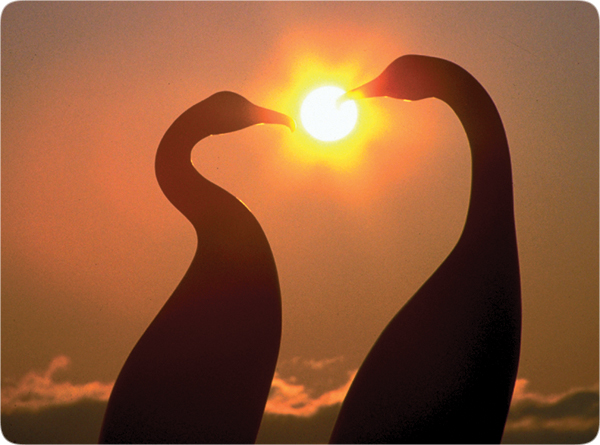Below is the online edition of In the Beginning: Compelling Evidence for Creation and the Flood,
by Dr. Walt Brown. Copyright © Center for Scientific Creation. All rights reserved.
Click here to order the hardbound 8th edition (2008) and other materials.
37. Sexual Reproduction

Figure 17: Male and Female Birds. Even evolutionists admit that evolution seems incompatible with sexual reproduction. For example, how could organisms evolve to the point where they could reproduce before they could reproduce?
If sexual reproduction in plants, animals, and humans is a result of evolutionary sequences, an unbelievable series of chance events must have occurred at each stage.
a. The amazingly complex, radically different, yet complementary reproductive systems of the male and female must have completely and independently evolved at each stage about the same time and place. Just a slight incompleteness in only one of the two at any stage would make both reproductive systems useless, and the organism would become extinct.
b. The physical, chemical, and emotional systems of the male and female would also need to be compatible.a
c. The millions of complex products of a male reproductive system (pollen or sperm) must have an affinity for and a mechanical, chemical,b and electricalc compatibility with the eggs of the female reproductive system.
d. The many intricate processes occurring at the molecular level inside the fertilized egg would have to work with fantastic precision—processes that scientists can describe only in a general sense.d
e. The environment of this fertilized egg, from conception through adulthood and until it also reproduced with another sexually capable adult (who also “accidentally” evolved), would have to be tightly controlled.
f. This remarkable string of “accidents” must have been repeated for millions of species.
Either this series of incredible and complementary events happened by random, evolutionary processes, or sexual reproduction was designed by intelligence.
Furthermore, if sexual reproduction evolved even once, the steps by which an embryo becomes either a male or female should be similar for all animals. Actually, these steps vary among animals.e
Evolution theory predicts nature would select asexual instead of sexual reproduction.f If asexual reproduction (splitting an organism into two identical organisms) evolved before sexual reproduction, how did complex sexual diversity arise—or survive?
If life evolved, why would any form of life live long beyond its reproductive age, when beneficial changes cannot be passed on? All the energy expended, supposedly over thousands of years and many evolutionary stages, to allow organisms to live beyond reproductive age would be a waste, until the evolutionary advantage had completely evolved. For example, Why do human females live past menopause? If there is no potential for reproduction, then according to evolution, there is no evolutionary reason to exist.
Darwin’s statement on page 19, can be generalized by adding the words in brackets:
If it could be demonstrated that any complex organ [or capability] existed which could not possibly have been formed by numerous successive, slight modifications, [none of which is harmful] my theory would absolutely break down.
Finally, to produce the first life form would be one miracle. But for natural processes to produce life that could reproduce itself would be a miracle on top of a miracle.g